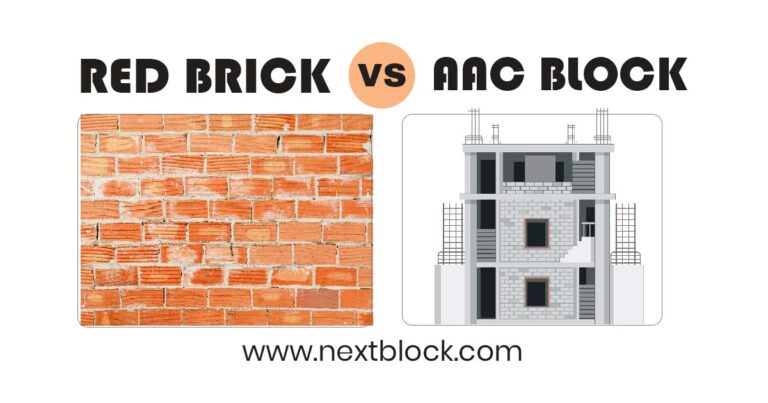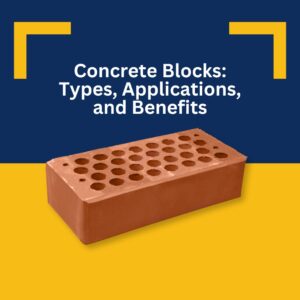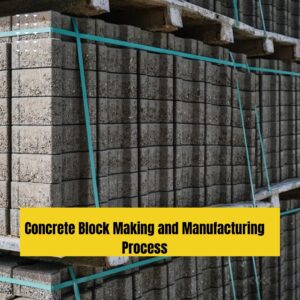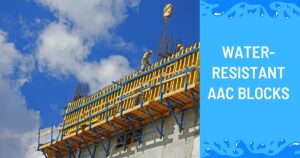Bricks are traditional, clay-based building material, whereas AAC blocks are made from lightweight aerated concrete. The key difference lies in their composition and weight, with AAC Autoclaved Aerated Concrete blocks being lighter and more energy efficient than bricks.
When it comes to building materials, the choice between bricks and AAC blocks can significantly impact construction projects. Both building and construction material have their advantages and unique properties that make them suitable for different types of construction. Bricks, known for their durability and classic aesthetic, have been a staple in construction for centuries.
In contrast, AAC blocks offer lightweight and energy-efficient properties, making them an environmentally friendly and cost-effective option for modern construction projects. Understanding the differences between these two building material is crucial for making informed decisions in construction and building projects.
What is Brick?
Brick also known as red brick is a building material typically made of clay or concrete. It is commonly used in construction for building wall, floors, and other structures. Red Bricks are known for their durability and strength, making them a popular choice for both residential and commercial buildings. They come in various sizes, shapes, and colors, allowing for creative designs and architectural styles. Traditional Red brick buildings often have a timeless and classic aesthetic, adding character and charm to any neighborhood or cityscape. Whether used as a primary material or as an accent, traditional red brick have stood the test of time and continue to be a reliable and versatile choice in the construction industry. For wall construction these traditional bricks are favorite choice.
What is Block?
Blocks are usually made from concrete or other materials like cinder blocks, which are composed of concrete and coal cinders. This concrete blocks are commonly used for building wall, foundations, and other structural elements. They are larger and heavier than bricks, providing strength and stability in construction. These blocks can be fire resistance and are often used in buildings that require high levels of fire safety. Fire resistance limit is AAC block is up to 1200℃. For wall construction Blocks are first choice.
AAC BLOCKS VS RED BRICKS – COMPARISON
1. Availability of sizes
The most important thing to think about when considering bricks or blocks for a structure is that they are able to be customized in size.
|
AAC Blocks |
Red Bricks |
|
AAC blocks are available in various types of shapes and can be customized according to your particular requirements. |
Red bricks available in one or two standard sizes. It is not possible to make changes. |
2. Technical properties
|
Difference |
AAC Blocks |
Red Bricks |
|
Height x Width |
AAC blocks are available in 600mm/625mm (length) X 100 – 300 mm (height) x 230/240 mm (width). |
Bricks are available in 225 mm (length) x 115 mm (width ) X 75/70 mm (Height). |
|
Dimension tolerance |
The dimension tolerance of the AAC block is +/-5 mm. |
The dimension tolerance of brick is +/- 5 mm to +/-15 mm or more. |
|
Density range |
Density ranges between 500-650 kg/cm3. |
Density ranges between 1400-1900 kg/cm3 |
|
Drying shrinkage |
The Drying shrinkage of AAC blocks is 0.4% which is very low in comparison with Conventional bricks. |
The drying shrinkage of bricks is 0.8% which is comparatively high compared with AAC blocks. |
3. Composition And Manufacturing Process
Bricks and Autoclaved Aerated Concrete block differ in their composition and manufacturing processes. Bricks are made from clay and are baked in a kiln, while These concrete blocks are made from a mixture of fly ash, cement, lime, and water and are cured through a chemical reaction.
| Brick Composition and Manufacturing |
| Bricks are typically composed of clay, shale, or a combination of both. The materials are molded into shape and then fired in a kiln at high temperatures. This process helps harden the brick and gives it its characteristic strength and durability. Bricks have been used for centuries and are known for their traditional appeal. Brick masonry is a construction technique that involves the use of bricks to build structures, walls, and other architectural elements. |
| AAC Block Composition and Manufacturing |
| AAC blocks, on the other hand, are made from a mixture of fly ash or sand, cement, lime, and water. The ingredients are combined to form a slurry, which is poured into molds and then subjected to autoclaving. The autoclaving process involves steam curing at high pressure, resulting in chemical reactions that cause the block to expand and harden. AAC blocks are lightweight and have excellent thermal insulation properties. |
4. Strength And Durability
Strength: Traditional Bricks are known for their compressive strength, typically ranging from 3.5 N/mm2 to 40 N/mm2 based on the type of brick. On the other hand, AAC blocks have a higher compressive strength, generally falling between 3 N/mm2 to 7 N/mm2.
Durability: Bricks have been widely used for centuries and are recognized for their durability. However, they may be susceptible to moisture and temperature changes. AAC blocks, being lightweight and having a closed-cell structure, offer enhanced durability, as they are more resistant to fire, pests, and other environmental factors.
5. Thermal And Sound Insulation
Thermal and sound insulation differ between brick and AAC block. The brick provides better thermal insulation, while the AAC block offers superior sound insulation.
| Thermal Insulation of Bricks | Thermal Insulation of AAC Block |
| Bricks have lower thermal insulation properties. | AAC block offer excellent thermal insulation. |
| They can absorb and retain heat. | They provide better energy efficiency. |
| Resulting in higher energy consumption for cooling. | Resulting in reduced energy consumption for heating or cooling. |
| Sound Insulation of Bricks | Sound Insulation of AAC Block |
| Bricks offer moderate sound insulation properties. | AAC block provide superior sound insulation. |
| Allowing more sound transmission. | Resulting in reduced sound transmission. |
6. Cost And Availability
Bricks and AAC blocks differ in cost and availability. Bricks are more widely available and generally cheaper, but AAC block price is lightweight and provide better thermal insulation, making them cost-effective in the long run.
Cost: The cost of bricks can vary depending on factors such as location, quality, and quantity required. Generally, bricks are considered to be more affordable compared to AAC blocks. AAC block, on the other hand, are known to be slightly more expensive due to the use of specialized technology in their manufacturing process. However, it’s important to consider the long-term benefits and durability that AAC blocks offer, which can offset the initial cost difference.
Availability: Bricks are widely available and can be sourced locally in most areas, making them easily accessible. On the contrary, AAC block may have limited availability depending on the location. However, with the growing demand for sustainable construction material, the availability of AAC blocks is steadily increasing. It’s recommended to check with local suppliers or manufacturers to ensure availability before making a purchasing decision. Overall, while bricks have a cost advantage and are more readily available, AAC blocks offer long-term benefits and enhanced durability. The choice between the two ultimately depends on the specific requirements, budget, and availability in your area.
7. Environmental Impact
Bricks and AAC Autoclaved Aerated Concrete blocks have different environmental impacts. Bricks are made from clay, which requires extensive excavation and can result in land degradation. Brick kilns also contribute to air pollution, as they release emissions such as carbon dioxide and sulfur dioxide. Additionally, bricks have a higher embodied energy compared to AAC blocks, meaning more energy is required for their production.
AAC blocks, on the other hand, are made from natural materials such as sand, cement, lime, and gypsum. They have a lower environmental impact as their production process involves less energy consumption and generates fewer emissions. AAC blocks also have better thermal insulation properties, reducing the need for energy-intensive cooling or heating systems.
In conclusion, while both bricks and AAC blocks are commonly used in construction, AAC blocks have a lesser environmental impact due to their production process and energy efficiency.
Why Choose Nextblock is Best for AAC Blocks
NextBlock Autoclaved is the most efficient and reliable autoclave on the market. It is trusted by professionals worldwide. It is trusted by professionals worldwide for its exceptional performance and durability. For AAC Autoclaved Aerated Concrete Block, NextBlock Autoclaved is the top choice. It ensures efficient and thorough curing of AAC blocks, resulting in superior quality and strength. NextBlock Autoclaved is the top choice for AAC Blocks in the market. Its advanced features and precise temperature control guarantee optimal curing conditions, leading to consistent and flawless results. Moreover, its robust construction and high-quality materials ensure long-lasting performance, making it the preferred autoclave for professionals in the industry. With NextBlock Autoclaved, AAC block manufacturers can confidently deliver superior-quality products that meet the highest standards in the market.
Frequently Asked Questions For What Is The Difference Between Brick Vs Aac Block
What Are The Key Differences Between Bricks And Aac Blocks?
Bricks are traditional building materials made of clay, while AAC blocks are lightweight, eco-friendly blocks made from fly ash, cement, and lime. Bricks have high compressive strength but are labor-intensive, whereas AAC blocks are larger and require less mortar. AAC blocks also have better thermal insulation properties compared to bricks.
Which Is More Cost-effective, Bricks Or Aac Blocks?
AAC blocks may have a higher upfront cost compared to bricks, but they can save money in the long run. The lightweight nature of AAC blocks reduces transportation costs and allows for faster construction. Additionally, AAC blocks offer better thermal insulation, resulting in energy savings and reduced maintenance costs.
Are AAC Blocks As Durable As Bricks?
AAC blocks are highly durable and can withstand heavy loads. They have higher resistance to fire, water, and pests compared to traditional clay bricks. The autoclaving process used to manufacture AAC blocks ensures uniform quality and strength. This makes AAC blocks a reliable choice for long-lasting and structurally sound buildings.
How long do AAC blocks last?
The best thing about AAC blocks is their exceptional durability. They last a very long time. Highly advanced technology and precise quantities of materials like weathering, water, and other external factors are used to make these blocks, which makes them a durable product the life of regular red bricks. A typical building of apartments lasts for 60 to 80 years. The average lifespan of AAC blocks to last up to 100 years.
How strong is the AAC block?
AAC blocks usually have a compressive strength of 3 to 4 N/mm², while clay bricks normally have a compressive strength of about 2.5 N/mm². Because it produce a higher compression strength, AAC blocks can be used in load-bearing structures. This maintains the building secure and risk-free.
Conclusion
Both bricks and AAC blocks have their own advantages and limitations. While bricks have been used for centuries and offer a traditional, durable option for construction, AAC blocks provide a lightweight and energy-efficient alternative. Ultimately, the choice between the two depends on factors such as cost, climate conditions, and construction requirements.
So, carefully considering your needs and consulting with professionals will ensure you make the right decision for your project.





